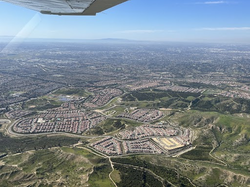Orchard Hills | |
|---|---|
Neighborhood | |
 Orchard Hills from the air, looking west. | |
| City | Irvine, California, U.S. |
| Area | |
• Total | 21.46 km2 (8.29 sq mi) |
| Population | |
• Total | 990 |
| • Density | 829.62/km2 (2,148.7/sq mi) |
| • | % of Irvine |
| GDP (PPA; 2021) | |
| • Per capita | $107,000 USD |
| Website | Orchard Hills Irvine Company Page |
Orchard Hills is a planned community in Irvine, California. It borders Limestone Canyon Regional Park to the northeast, California State Route 241 to the southeast, the Northwood neighborhood to the southwest, and California State Route 261 to the northwest. Orchard Hills is home to the Rattlesnake and Syphon reservoirs.
